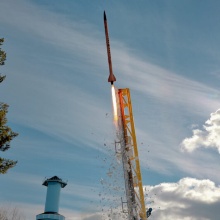The Hybrid Engine Development (HyEnD) team from the University of Stuttgart broke the world altitude record for student hybrid rockets on Tuesday, April 18, 2023. Another world record attempt for student rockets in general was unfortunately not successful. The students launched their two rockets from the Swedish rocket launch site Esrange near Kiruna.
"The first countdown and the launch were very successful. We were also able to recover the rocket successfully and bring it back to the launch site. However, there were problems with the main chute during landing, which meant that the landing speed was higher than expected," reports Julian Dobusch, head of propulsion development, from Sweden. The students reached a flight altitude of more than 64 kilometers. They thus beat their own altitude record of 32 kilometers, which they set in 2016.
The students wanted to cross the boundary into space at an altitude of 100 kilometers with a second hybrid rocket on Monday, April 24, setting another world record for student rockets in general. Unfortunately, it didn't go well. An anomaly occurred during the flight, the students inform. Therefore, the 64-kilometer flight altitude of the launch of the first rocket last week could not be reached again. The team plans to announce further details in the coming days and weeks. The previous record is 103.6 km and was set by the University of Southern California (USCRPL) team in 2019. Impressions from Sweden can be seen on the HyEnD website.
The launch - a special moment
In Sweden, 16 members of the student group are on site, including 25-year-old project leader Öchsle: "The launch of the rocket will be a very special moment for me. Over the past three years, a lot of heart and soul has gone into this project from each and every one of us. Before the launch, it will certainly be exciting again during the countdown, but we are confident that everything will go according to plan. Of course, I'm most looking forward to the moment when the rocket takes off."
Hybrid engine delivers 1.5 t of thrust
In order to be on the safe side, the students have two identical rockets on site. On one hand so they have a back-up in case something breaks during launch preparations. On the other hand, because the rocket project is quite ambitious for a group of students. For the first flight of an untested rocket, there are restrictions on the launch angle and thus on the flight altitude. If the first flight goes well, students hope to fly higher on the second launch.
The hybrid rocket is 7.80 m long and weighs around 70 kg. It was built by around 60 students from the University Group HyEnD of the University of Stuttgart. “It’s one of the most powerful and advanced student-built hybrid rockets in the world,” says Max Öchsle, HyEnD project manager. With this, the students have big plans: They want to beat their own altitude record of 32 km for student-built hybrid rockets, which they set in 2016.
The N2ORTH rocket has a hybrid engine that uses solid fuel and liquid nitrous oxide. The name N2ORTH alludes to both nitrous oxide (N2O), which is used as an oxidizer, and the launch site in the North. In order to make it as light as possible, it was built almost entirely of composite materials.
“We are particularly proud of the engine which we developed ourselves. With its thrust of up to 1.5 t, it is one of the most powerful and efficient student made engines in the world. Another special feature is the parachute, which must be able to withstand supersonic speeds. Because there are no commercial parachutes available for these requirements, we made it ourselves,” says Öchsle. Because of the high flight speeds, the rocket shell is exposed to enormous temperatures. The structural parts were therefore laminated with a high-temperature epoxy system developed in house. The rocket also has a thermal protection layer made of cork. The students manufactured most of the components themselves in the workshops of the University of Stuttgart.
The development of the rocket was made possible by the STERN student experimental rocket program funded by the German Aerospace Center (DLR). The project began in the fall of 2019, and the launch in Sweden will mark the completion. The project is located at the Institute of Space Systems (IRS) at the University of Stuttgart. The Materials Testing Institute provided workshops and rooms. In addition, numerous other institutes have supported the students in their endeavors.
Website and social media
- Website with current schedule and regular blog articles
- On their Instagram account @hyend_uni-stuttgart, the students provide daily information during their stay in Sweden.
| Contact | Julian Dobusch, Press and Public Relations HyEnD, University of Stuttgart, E-Mail |
|---|


